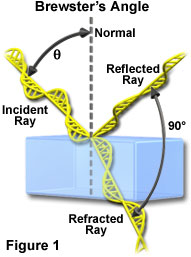Brewster's angle
The Brewster angle ( after Sir David Brewster, 1781-1868 ) or polarization angle is a size of the optics. It specifies the angle, only the perpendicular to the plane of incidence (ie parallel to the interface ) polarized components are reflected in the incident, unpolarized light. The reflected light is then linearly polarized.
Physical Basics
Light which impinges on a boundary surface between two media with refractive indices and is reflected or transmitted in accordance with the Fresnel formulas. According to the Fresnel formulas, the reflectivity depends on both the incident angle and the refractive indices, as well as the polarization of the incident light (see figure).
For light having a polarization parallel to the plane of incidence, which is incident with the Brewster angle, there is no reflection. The light passes completely through the surface. Light with vertical polarization, however, is also partially reflected. The reflected light is thus completely linearly polarized.
Hereinafter, it is assumed that the jet impinges on the air from another material. For air can be assumed to a good approximation a refractive index of. The material has the refractive index.
In the transition between any two non-magnetizable media, the Brewster angle is obtained from the Snell's law of refraction:
Where n1 is the refractive index of the medium in which it is measured, and n2 is the refractive index of the other medium.
The incident light beam excites the electrons of the material to vibrate at ( induced polarization ). It is created by a collection of atomic dipoles that oscillate in the polarization direction and thereby radiate secondary waves. According to the optical laws of reflection (angle of incidence equal to angle of reflection ) of the beam is reflected at the reflection angle.
The special feature of light at the Brewster angle is that the refracted at the angle beam is orthogonal to the reflected. Therefore, the entire polarized parallel to the plane of incidence light is refracted and reflected only the polarized perpendicular to the plane of incidence proportion. The explanation for this lies in the radiation pattern of a dipole ( forced oscillation ): In the direction of the dipole axis, which here is identical with the direction of reflection, no radiation takes place.
Example - reflection on glass
Using the preceding section it is apparent that a glass plate can be used as the polarizer, by being irradiated at the Brewster angle.
With the above-identified angles and the law of refraction applies:
Assuming the materials used in air () and ordinary glass ( soda-lime glass, Note: fused silica (), and accordingly there ) if it were ideal, non-absorbent materials ( dielectrics), applies the Brewster described above Act:
For the transition from air to glass results in a Brewster angle:
According to the Fresnel equations are obtained for the perpendicular or parallel component of the incident light, the following reflectance values (respectively):
With and
The reflected light is thus completely polarized perpendicular to the plane of incidence linear.
For irradiation of unpolarized light (all polarizations represent the same) can be the reflectance on the arithmetic mean of the two components determine the following applies:
Therefore, only 8.5 % of the incident intensity is reflected ( the Brewster angle ) For the described transition from unpolarized light.










